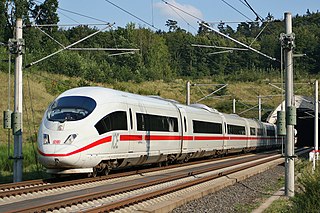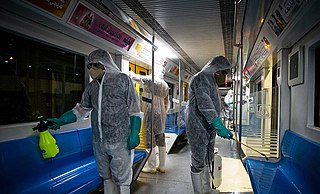This article needs to be updated.(March 2011) |
| Years in rail transport |
|---|
| Timeline of railway history |
This article lists events related to rail transport that occurred in 2010.
This article needs to be updated.(March 2011) |
| Years in rail transport |
|---|
| Timeline of railway history |
This article lists events related to rail transport that occurred in 2010.
This section has multiple issues. Please help improve it or discuss these issues on the talk page . (Learn how and when to remove these messages)
|
| Group | Gold medal | Silver medal | Bronze medal |
|---|---|---|---|
| A | |||
| B | |||
| C | |||
| S&T |

Eurostar is an international high-speed rail service in Western Europe, connecting Belgium, France, Germany, the Netherlands and the United Kingdom.

The TGV is France's intercity high-speed rail service, operated mainly by SNCF. SNCF worked on a high-speed rail network from 1966 to 1974 and presented the project to President Georges Pompidou who approved it. Originally designed as turbotrains to be powered by gas turbines, TGV prototypes evolved into electric trains with the 1973 oil crisis. In 1976 the SNCF ordered 87 high-speed trains from Alstom. Following the inaugural service between Paris and Lyon in 1981 on the LGV Sud-Est, the network, centred on Paris, has expanded to connect major cities across France and in neighbouring countries on a combination of high-speed and conventional lines. The TGV network in France carries about 110 million passengers a year.

Thalys was a brand name used for high-speed train services between Paris Gare du Nord via Brussels-South to either Amsterdam Centraal or to German cities in the Rhein-Ruhr, including Aachen, Cologne, Düsseldorf, Duisburg, Essen and Dortmund.

Intercity Express is a high-speed rail system in Germany. It also serves destinations in Austria, France, Belgium, Switzerland and the Netherlands as part of cross-border services. It is the flagship of the German state railway, Deutsche Bahn. ICE fares are fixed for station-to-station connections, on the grounds that the trains have a higher level of comfort. Travelling at speeds up to 300 km/h (190 mph) within Germany and 320 km/h (200 mph) when in France, they are aimed at business travellers and long-distance commuters and marketed by Deutsche Bahn as an alternative to flights.

The Tokyo Metro is a major rapid transit system in Tokyo, Japan, operated by the Tokyo Metro Co. With an average daily ridership of 6.52 million passengers, the Tokyo Metro is the larger of the two subway operators in the city; the other being the Toei Subway, with 2.85 million average daily rides.

Korea Train eXpress (Korean: 한국고속철도), often known as KTX, is South Korea's high-speed rail system, operated by Korail. Construction began on the high-speed line from Seoul to Busan in 1992. KTX services were launched on April 1, 2004.

The Federal District Metro is the rapid transit system of the Federal District, in Brazil. It is operated by Companhia do Metropolitano do Distrito Federal and was opened in 2001. Currently, Federal District's Metro has 27 stations on two lines, and it runs for 42.38 kilometers (26.33 mi). The system passes through 6 Administrative regions of the Federal District, those being Brasília, Guará, Águas Claras, Taguatinga, Ceilândia, and Samambaia.

CRRC Changchun Railway Vehicles Co., Ltd. is a Chinese rolling stock manufacturer and a division of the CRRC. While the CRV emerged in 2002, the company's roots date back to the establishment of the Changchun Car Company in 1954. The company became a division of CNR Corporation before its merger with CSR to form the present CRRC. It has produced a variety of rolling stock for customers in China and abroad, including locomotives, passenger cars, multiple units, rapid transit and light rail vehicles. It has established technology transfer partnerships with several foreign railcar manufacturers, including Bombardier Transportation, Alstom, and Siemens Mobility.
The X'Trapolis 100 is a class of single deck electric multiple units part of Alstom's X'Trapolis family of trains, operated in Melbourne, Victoria, Australia and Valparaíso, Chile.

Rotterdam Centraal station is the main railway station of the city Rotterdam in South Holland, Netherlands. The station received an average of 112,000 passengers daily in 2019. The current station building, located at Station Square, was officially opened in March 2014.
High-speed rail service commenced in Poland on 14 December 2014, with the introduction of 20 non-tilting New Pendolino trainsets operating on 4 designated lines radiating out from Warsaw. Polish State Railways started passenger service using Pendolino trains operating at a maximum speed of 200 km/h on 80 km line Olszamowice-Zawiercie. From December 2017 there are two 200 km/h sections, 136 km long in total. All high-speed services operated by PKP in Poland are branded as Express Intercity Premium (EIP).

The British Rail Class 374, also referred to as the Eurostar e320, is a type of electric multiple unit passenger train used on Eurostar services through the Channel Tunnel to serve destinations beyond the core routes to Paris and Brussels. They began to run passenger services in November 2015. The trains, owned by Eurostar International Limited, are sixteen-coach versions of the Siemens Velaro. Each train is 390.2 m (1,280 ft) long. The trains are compliant with the Technical Specifications for Interoperability (TSI).

The Abidjan Metro is a 37.5-kilometre (23.3 mi) rapid transit network under construction serving the Ivorian economic capital of Abidjan. Construction of the network started in November 2017, with the beginning of passenger service originally expected in 2022–2023, but has since been delayed due to the COVID-19 pandemic to at least 2028. Initially planned to comprise a single line with 13 stations undertaken by Bouygues-Dongsan, a French-Korean consortium, the project has since then been expanded to a single north–south line with 20 stations, financed 100% by France and built solely by three French groups after the withdrawal of the South Korean partners from the consortium in October 2017.

Passenger rail ridership plummeted worldwide amid the COVID-19 pandemic; many services were reduced in frequency or discontinued outright.